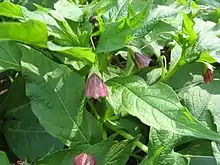Scopolia japonica
Scopolia japonica, also Japanese belladonna or Korean scopolia,[1] is a flowering plant species in the genus Scopolia - one of the eight genera in tribe Hyoscyameae of the nightshade family Solanaceae.
| Scopolia japonica | |
|---|---|
 | |
| Scientific classification | |
| Kingdom: | Plantae |
| Clade: | Tracheophytes |
| Clade: | Angiosperms |
| Clade: | Eudicots |
| Clade: | Asterids |
| Order: | Solanales |
| Family: | Solanaceae |
| Genus: | Scopolia |
| Species: | S. japonica |
| Binomial name | |
| Scopolia japonica | |
The coumarins umbelliferone and scopoletin have been isolated from the roots of Scopolia japonica. The hairy roots technique has also been used to produce the alkaloids scopolamine and hyoscyamine.[2]
Gallery
 Plant in flower.
Plant in flower. Single flower (interior).
Single flower (interior). Scopoliae Rhizoma (root of Scopolia japonica)
Scopoliae Rhizoma (root of Scopolia japonica)
References
- English Names for Korean Native Plants (PDF). Pocheon: Korea National Arboretum. 2015. p. 630. ISBN 978-89-97450-98-5. Archived from the original (PDF) on 25 May 2017. Retrieved 19 December 2016 – via Korea Forest Service.
- Yoshihiro Mano; Shigeyasu Nabeshima; Chiaki Matsui; Hideo Ohkawa (1986). "Production of Tropane Alkaloids by Hairy Root Cultures of Scopolia japonica". Agric. Biol. Chem. 50 (11): 2715–22. doi:10.1080/00021369.1986.10867820.
| Wikimedia Commons has media related to Scopolia japonica. |
This article is issued from Wikipedia. The text is licensed under Creative Commons - Attribution - Sharealike. Additional terms may apply for the media files.